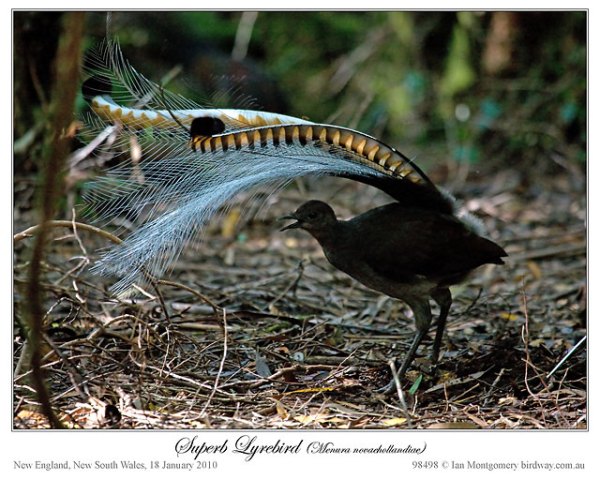You’ll hardly believe this LyreBird is real!
******************
A Lyrebird is either of two species of ground-dwelling Australian birds, that are most notable for their superb ability to mimic natural and artificial sounds from their environment. Lyrebirds have unique plumes with two large prominent banded feathers and many delicate intermediate neutral colored tail feathers.
They are among Australia’s best-known native birds. In addition to their extraordinary mimicking ability, Lyrebirds are notable because of the striking beauty of the male bird’s huge tail when fanned out in display.
The Lyrebirds are ground living birds with strong legs and feet and short rounded wings. They are generally poor fliers and rarely take to the air. The Superb Lyrebird is the larger of the two species. Females are up to 33 inches long, and the males are up to a larger 37 inches long. Albert’s Lyrebird is slightly smaller at a maximum of 35.5 inches (male) and 33 inches(female). They have smaller, less spectacular feathers than the Superb Lyrebird, but are otherwise similar.
Lyrebirds sing throughout the year, but the peak of the breeding season, from June to August, is when they sing with the most intensity. During this peak they may sing for four hours of the day, almost half the hours of daylight. The song of the Superb Lyrebird is a mixture of seven elements of its own song and any number of other mimicked songs and noises. They have extraordinary ability, unmatched in vocal repertoire and mimicry. Lyrebirds render with great fidelity the individual songs of other birds and the chatter of flocks of birds, and also mimic other animals such as koalas and dingos. They are capable of accurately imitating almost any sound, and they have been recorded mimicking human caused sounds such as a mill whistle to a cross-cut saw, chainsaws, car engines and car alarms, fire alarms, rifle-shots, camera shutters, dogs barking, crying babies, music, and even the human voice.
The Superb Lyrebird’s mimicked calls are learned from the local environment, including from other Superb Lyrebirds. An instructive example of this is the population of Superb Lyrebirds in Tasmania, which have retained the calls of species not native to Tasmania in their repertoire, but have also added some local Tasmanian endemic bird noises. It takes young birds about a year to perfect their mimicked repertoire. The female Lyrebirds of both species are also mimics, and will sing on occasion but the females do so with less skill than the males.
Source: From Wikipedia, licensed under CC-BY-SA
And NOW, introducing the star of this show, the famous and unforgettable, LyreBird:
If you have any views on this, or experiences of your own you’d like to share, I’d love to hear from you – please leave a comment below.
Jack
TheNatureOfHiking.com
Find us on Google+, Facebook, and Twitter


